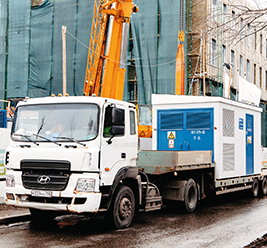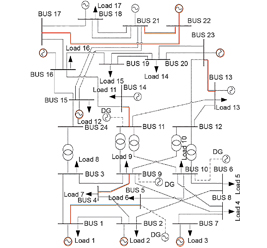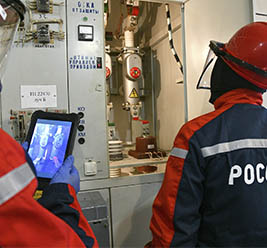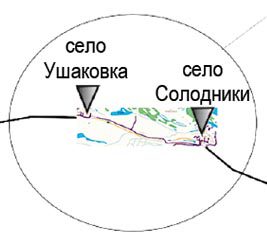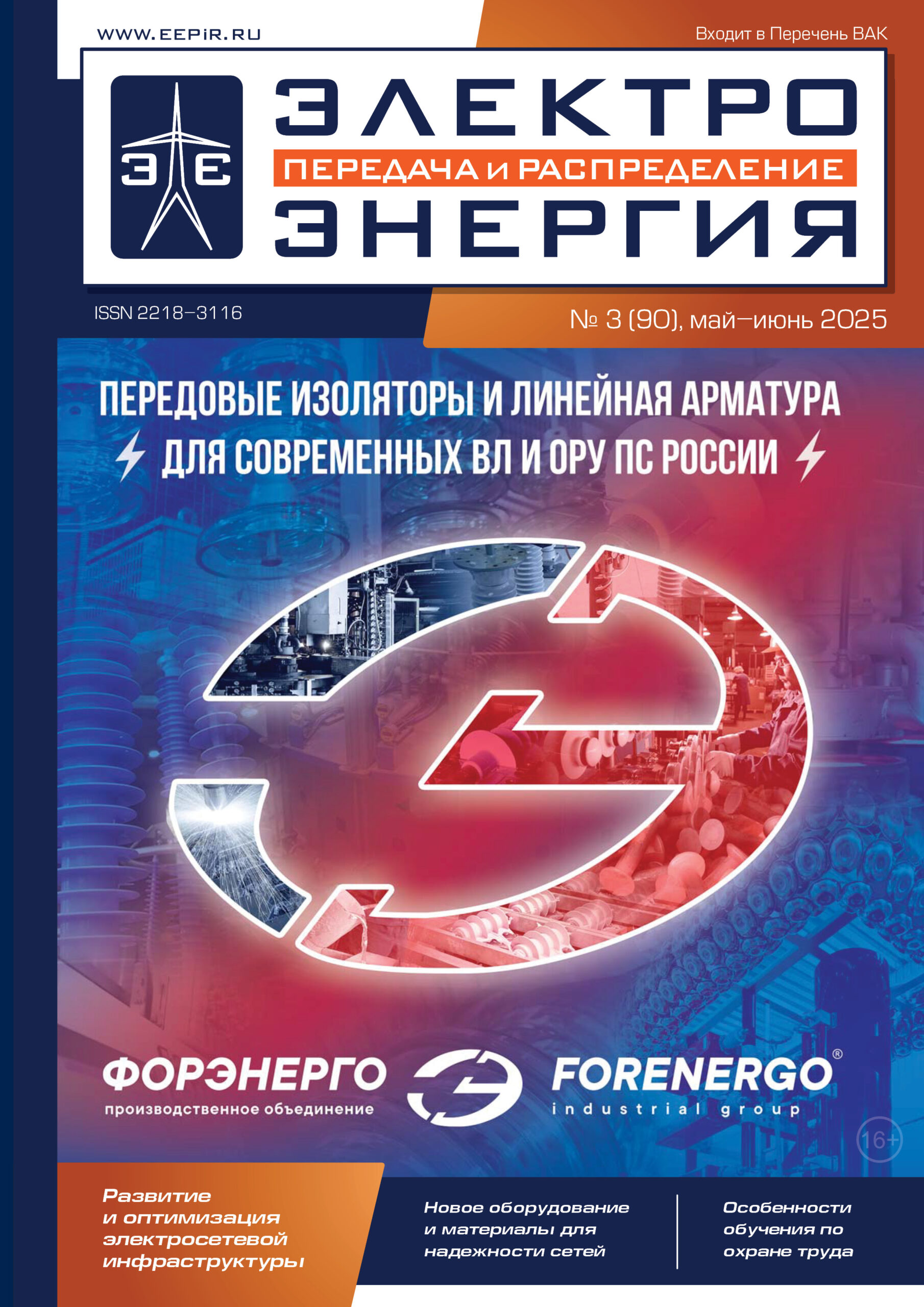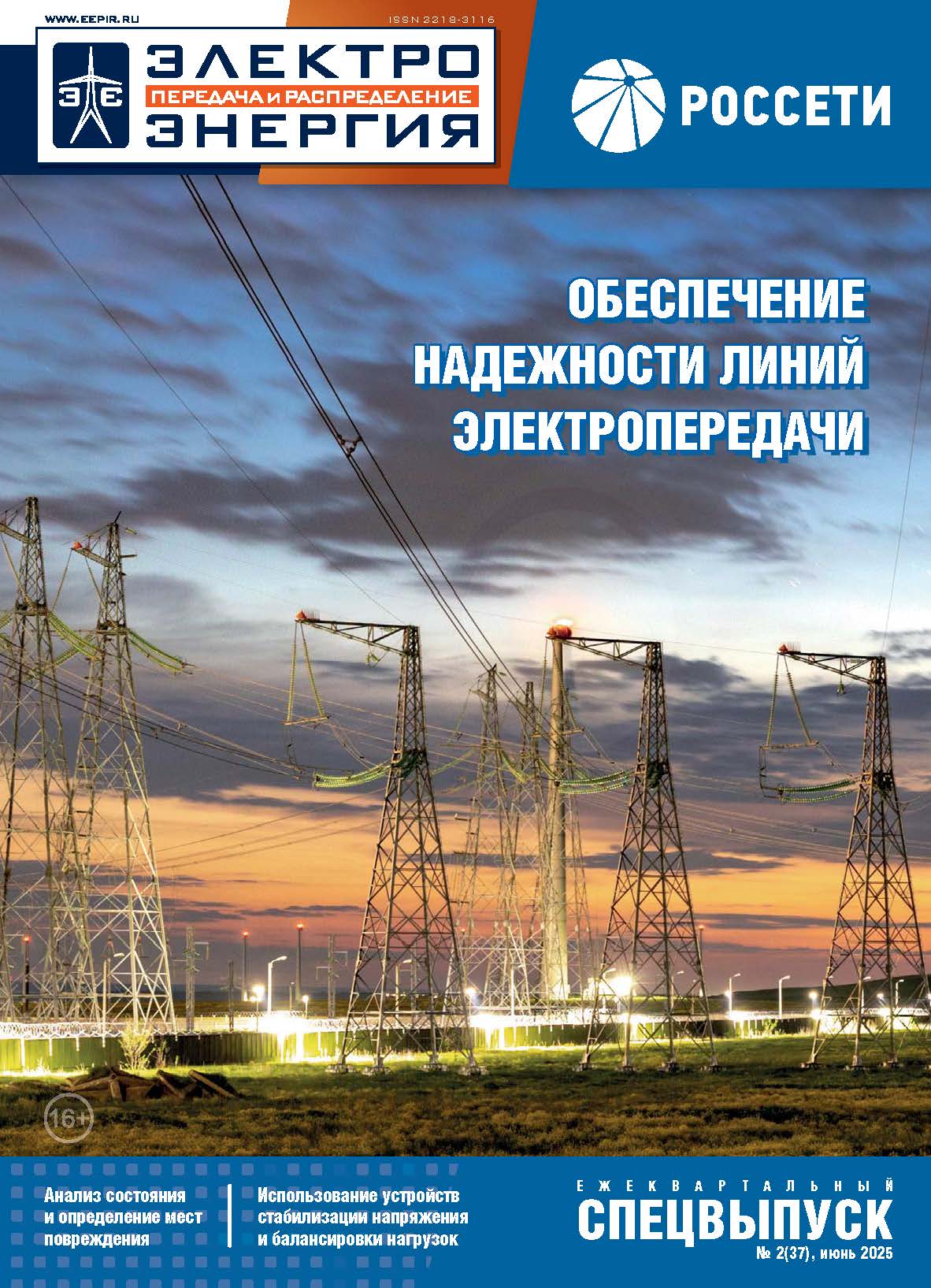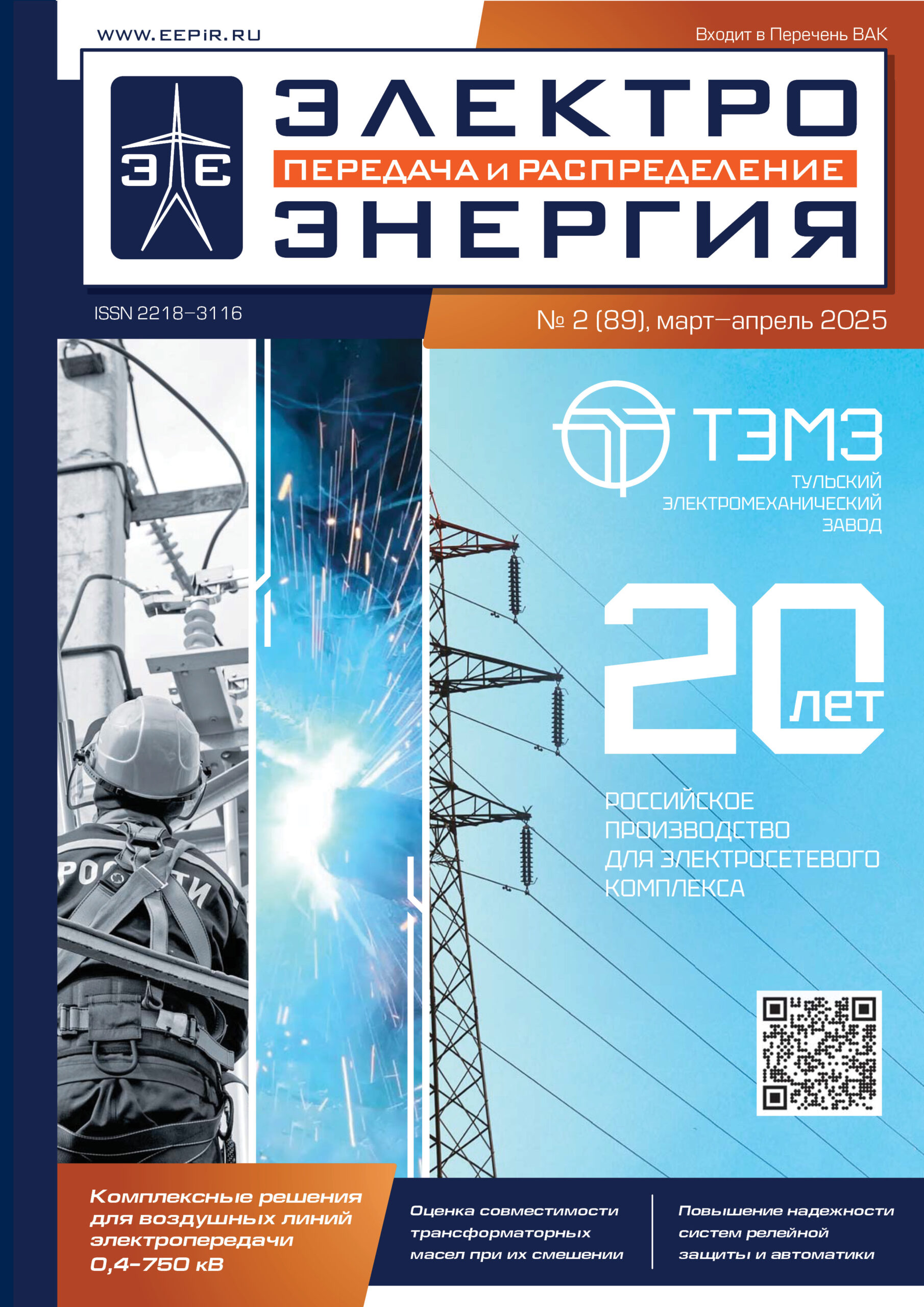
The MAIN JOURNAL for POWER GRID SPECIALISTS in RUSSIA

6
August 25–29, France, Paris
Asset Management
Keywords:
asset management, asset management
maturity model, ef
fi
ciency management, power supply
reliability.
Abstract:
At present, development and integration of uniform
principles and mechanisms of physical asset management
(PAM) in all subsidiaries of JSC “Russian Grids” is
one of priority directions of the company’s activities.
Assessment of PAM organizational maturity level is a
tool which enables estimating the maturity degree of PAM
components in Subsidiaries. At JSC “Russian Grids”
the given tool was suggested as an auxiliary method of
shaping PAM development plans of subsidiaries based
on common logic. The approach for developing the asset
management maturity model is based on quality analysis
of conformance of Subsidiaries’ PAM to the upper-level
PAM model of JSC “Russian Grids”. PAM maturity
organizational level assessment model was developed
with reference to the international standard PAS 55 and
materials of international companies accredited for
PAS 55-based quali
fi
cation, with account for the nature
of currently implemented projects in transmission and
distribution companies. The results of the conducted
work were used for choosing main directions of PAM
development at JSC “Russian Grids” and its subsidiaries.
COMPANY INTRODUCTION AND PROBLEMS
OF PAM DEVELOPMENT IN
AN ELECTRIC GRID SECTOR
The problem of development of common principles
and rules for asset management for the electric grid
companies arose at the start of power industry reformation
process. Inhomogeneity and conservatism of methods
cause complications in assessing results of separate
companies’ activities and in decision-making in cases of
lower ef
fi
ciency rates. Besides, the problems of improving
ef
fi
ciency came to relate to rising demands of consumers,
shareholders, investors, other companies in the industry,
regulatory authorities and the state, which required
transition from management of separate processes within
Approach to Developing the Physical
Asset Management Maturity Model
for JSC “Russian Grids”
Evgenia KORNIENKO (
Евгения
КОРНИЕНКО
),
JSC “Russian Grids”
Irina VOLKOVA (
Ирина
ВОЛКОВА
),
National Research University
1
Main electricity grids of JSC “FGC UES” -Uni
fi
ed National
Energy Grid (UNEG), distribution grids of JSC “IDGC
Holding” -distribution grid companies (DGC).
an organization to system management, formation not only
of balance performance and ef
fi
ciency within companies
and their af
fi
liates, but also of the balance of reliability,
risks and costs at the level of all stakeholders.
JSC “Russian Grids” was established in 2012 within
the framework of global structural reforms in power
industry. It united main electricity grids of JSC “FGC
UES” and distribution grids of JSC “IDGC Holding”
1
[1].
The aim of consolidation of the companies was to
form a uniform body in the power grid sector for solving
tasks of improving operating and investment ef
fi
ciency,
increasing quality and reliability of services on power
transmission and distribution, availability and security of
the grid infrastructure, as well as solving general tasks of
optimizing mechanisms of industry regulation within the
framework of activities under jurisdiction.
In accordance with the Order of the Government of RF
of April 3, 2013
№
511-
р
“On approval of the Strategy of
Russian power grid sector development”:
• Main priority activities of main power grid sector is
maintaining and developing grid infrastructure (lines
and transformers), which enables power generation by
power plants and power transmission to distribution
grids, as well as providing state’s energy security;
• The aim of operation of the distribution grid sector
is long-term provision of reliable, high-quality and
affordable power supply of consumers in the whole
territory of the respective region at the stage of electric
power distribution by organizing infrastructure of
maximum ef
fi
ciency [2].
JSC “Russian Grids” Group of companies operates
2.2 million km of power transmission lines, 473 thousand
of substations with transformer capacity of more than
более
748 GW. In 2013 the net electric power supply to
consumers amounted to 706 billion kWh. The personnel
number is 222 thousand people.

7
info@eepr.ru, www.eepr.ru
JSC “Russian Grids” is also one of the most prominent
infrastructure companies in Russia, being under state
control and acting as its agent for Russian power grid
sector management.
Formation of a uniform transparent system of
managing assets of JSC “Russian Grids” and its
subsidiaries is at present a way to solve the set tasks
of meeting reliability standards and improving tariff-
making transparency.
PAM is systematic, regular and coordinated activity
on optimal management of technical condition,
reliability, costs, risks and performance of equipment
(assets) throughout its life cycle with the aim of
achieving strategic goals of JSC “Russian Grids” Group
of companies.
The asset management system is interconnected
and jointly used process diagrams, indicators of their
ef
fi
ciency, rules, methods, algorithms, regulatory and
reference information, information systems and databases
for exerting systematic impact on assets, reliability of
their use, risks and costs throughout the life cycle with
account for the Company’s strategic aims [3, 4].
In 2005—2010 a number of asset management
concepts were developed in companies of the distribution
grid sector of JSC “IDGC Holding” and JSC “FGC UES”,
and some of them are partially implemented now.
Main prerequisites for development of a uniform
asset management system at JSC “Russian Grids” are the
following:
• need in meeting requirements of RAB-regulation as
regards conformance to standards of power supply
reliability with simultaneous reduction of costs for
modernizing and renovating power grids and restricting
growth rates of end consumer electricity tariffs;
• impossibility of using the existing asset management
principles — impact with the standard periodicity rates
due to limited resources. Thus, it causes the need in
choosing priorities of activities;
• need in assessment, analysis, regular monitoring
of operating performance and optimal distribution
of
fi
nancial resources for improving quality of
management-related decision-making along the whole
organization vertical.
JSC “Russian Grids” and its Subsidiaries face the
following external and internal factors that make it
impossible to simultaneously set identical target goals for
all subsidiaries within a short time period:
• imperfection of the regulatory base in the
fi
eld
of equipment operation, repairs and replacement.
Absence of fully implementable methods and rules
for assessing equipment condition, risks, criticality
and consequences of equipment failures, as well as
methods of equipment repair and replacement planning
with regard to the enumerated characteristics;
• inhomogeneity of asset management methods used in
different af
fi
liates of DGC and UNEG;
• need in developing a uniform system of goal-setting,
organization, ful
fi
llment and assessment of PAM
ef
fi
ciency in new conditions;
• incompleteness of the balanced scorecard system of
PAM ef
fi
ciency, use of plan/actual analysis based on
separate cost and physical parameters;
• insuf
fi
cient level of asset and consumer information
adequacy, which makes meaningful strategic
and operational planning, monitoring and asset
management ef
fi
ciency assessment impossible;
• inadequate development of the uniform information
exchange model, which would encompass all
company’s management levels.
All the above mentioned features and complications
represent relevant issues that, according to the international
practices, can be solved within the framework of a uniform
PAM model of grid companies.
The upper-level PAM model was suggested at the initial
stage of formation and re
fi
ning of the uniform PAM model
of JSC “Russian Gris”, conforming to the requirements of
the international standard PAS 55.
While forming plans of prospective development and
changing PAM approaches, it is necessary to take into
account presence of strategic aims of main and distribution
grid companies, as well as levels and special features of
technical and economic conditions of all Subsidiaries,
organizational peculiarities and the level of understanding
of the need in changes within the company by its workers.
With the aim of setting realistic tasks in each company,
further gradual development in PAM uniform logic and
coherent transition to asset life cycle management, the
stage of planning integration of results of PAM-related
activities carried out by 15 companies is preceded by the
stage of development of PAM maturity model of JSC
“Russian Grids” and estimation of maturity level of each
Subsidiary.
DEVELOPING THE ASSET MANAGEMENT
MATURITY MODEL FOR JSC
“RUSSIAN GRIDS”
There exists quite a number of approaches to
assessment the maturity level of the management,
information system and software (business processes,
quality management, people capability maturity model,
knowledge management, system engineering, software
acquisition or integration capability maturity models
etc.) [6—10]. Basic principles of the PAM maturity
assessment for infrastructural companies are described in
the international standard PAS 55 [11].
The PAS 55 conventional model suggests determining
of the company’s PAM system conformance to one of
5 maturity levels (Learning, Applying, Embedding,
Optimizing and planning, Beyond PAS 55) and making
conclusions about gaps and unconformities based on 28
PAS 55 criteria. The assessment is conducted on the basis
of internal audit of business processes, regulatory and
standard documentation, PAM information system and
surveys of key workers.
Taking into account that quite recently Russian
companies have started thinking about transformation of
approaches to PAM and integrating separate components
described in PAS 55, and the fact that the power grid

8
August 25–29, France, Paris
Asset Management
sector structure underwent signi
fi
cant organizational
changes during the industry reformation period, and,
as a consequence, the vision of the sequence of steps in
transition to risk-, performance- and cost-based asset
management changed, at present it is important for JSC
“Russian Grids” not just to compare the level of PAM
conformance to international requirements, but to assess
and compare the PAM development levels in Subsidiaries
to
fi
nd the best way of PAM development at JSC “Russian
Grids” and its subsidiaries.
With this aim, an approach to determine the
organizational PAM maturity level in subsidiaries of JSC
“Russian Grids” based on upper-level PAM model was
suggested.
Figure 1 shows the process of use of PAM maturity
model at JSC “Russian Grids”. Figure 2 demonstrates the
PAM upper-level model at JSC “Russian Grids” [3, 4,
5, 12].
Materials of PAS 55, of international companies
accredited for PAS55 quali
fi
cation [13] and internal
sources of data about the results of integration of
current PAM projects in RGC and UNEG
2
were used to
develop a PAM maturity model for JSC “Russian Grids”
(Fig. 3), which is described below. A questionnaire
was made based on the description data, and a survey
of experts of JSC “Russian Grids”, its subsidiaries
and af
fi
liates was conducted. Analysis of quality
characteristics of PAM upper-level model components
(Fig. 1) shows conformance of the existing PAM model
in a Subsidiary to PAM maturity level of JSC “Russian
Grids” with account for companies’ peculiarities and
special implementation features of certain projects.
Experts, accountable for integration of the asset
management system in Subsidiaries, are assessed by each
questionnaire item according to 100-point scale. The
fi
nal
Fig. 1. Process of use of PAM maturity model at JSC “Russian Grids”
2
Projects now implemented in DGC: a project of 2011—2013
on integration of a comprehensive asset management system
[4], a project on development of a geoinformational system
of distributed resource management, integration of a system
for recording and analysis of technological disturbance
investigation results, etc. Projects now implemented
in UN
Е
G: integration and development of a system of
equipment maintenance and repair management, creation of
a regulatory budget system, etc.
Formation of
an upper-level
PAM model for
JSC “Russian
Grids”
Development
PAM Maturity
Model (maturity
matrix and
questionnaire)
Assess and analyze
business unit PAM
model. Subsidiary
and upper-level
PAM model
compliance
Formation of the
Subsidiaries PAM
development.
Detailing the
upper-level PAM
model for JSC
“Russian Grids”
PAM plans
implementation
and realization
indicator of maturity organizational level is calculated as
the average value of answers to twenty questions.
Figure 3 can be used to follow the evolution of PAM
model to be integrated in JSC “Russian Grids”, while the
results of expert surveys and
fi
nal assessment of maturity
organizational level can be used to estimate the actual
PAM condition in DGC and UNEG.
PAM maturity organizational level assessment
model can be used to describe the best practices and
targets for JSC “Russian Grids” group of companies,
to describe the sequence of changing PAM components
with the aim of stable development and benchmarking
of Subsidiaries.
Description of maturity model for PAM of JSC
“Russian Grids” (Fig. 1, 2):
Section1 includes a survey to understand the general
requirements for asset management system, approved by
common documents for all utility companies at a certain
level of development. This section contains 6 general
questions.
Section 2 de
fi
nes the requirements for PAM Policy and
Strategy. The section contains 5 positions corresponding
to each issue.
Position 2.1 re
fl
ects the need to develop and implement
uniform policy for PAM in all Subsidiaries.
Position 2.2 explains PAM Strategy coordination
with power grid Policy and Strategy and requirements of
external stakeholders, as well as determines the strategy
effects on equipment, which adheres the Company to a
certain level of development and an impact strategy that
actually realized.
Position 2.3 shows, whether life cycle of assets are
considered in the planning of network development?
Position 2.4 de
fi
nes the necessity of existence in
Subsidiaries and “Russian Grids” PAM development plan
conditioned by the level of maturity of PAM.
Position 2.5 de
fi
nes operational and investment
methodology at a given level of maturity of PAM.
Section 3 de
fi
nes the requirements for processes and
asset management methodologies. The section contains 5
questions.
Position 3.1 reveals features performing maintenance
and repair (MR) processes.
Position 3.2 reveals features executing retro
fi
tting
and upgrading processes, new construction and
expansion of existing facilities (renovation and new
building process).
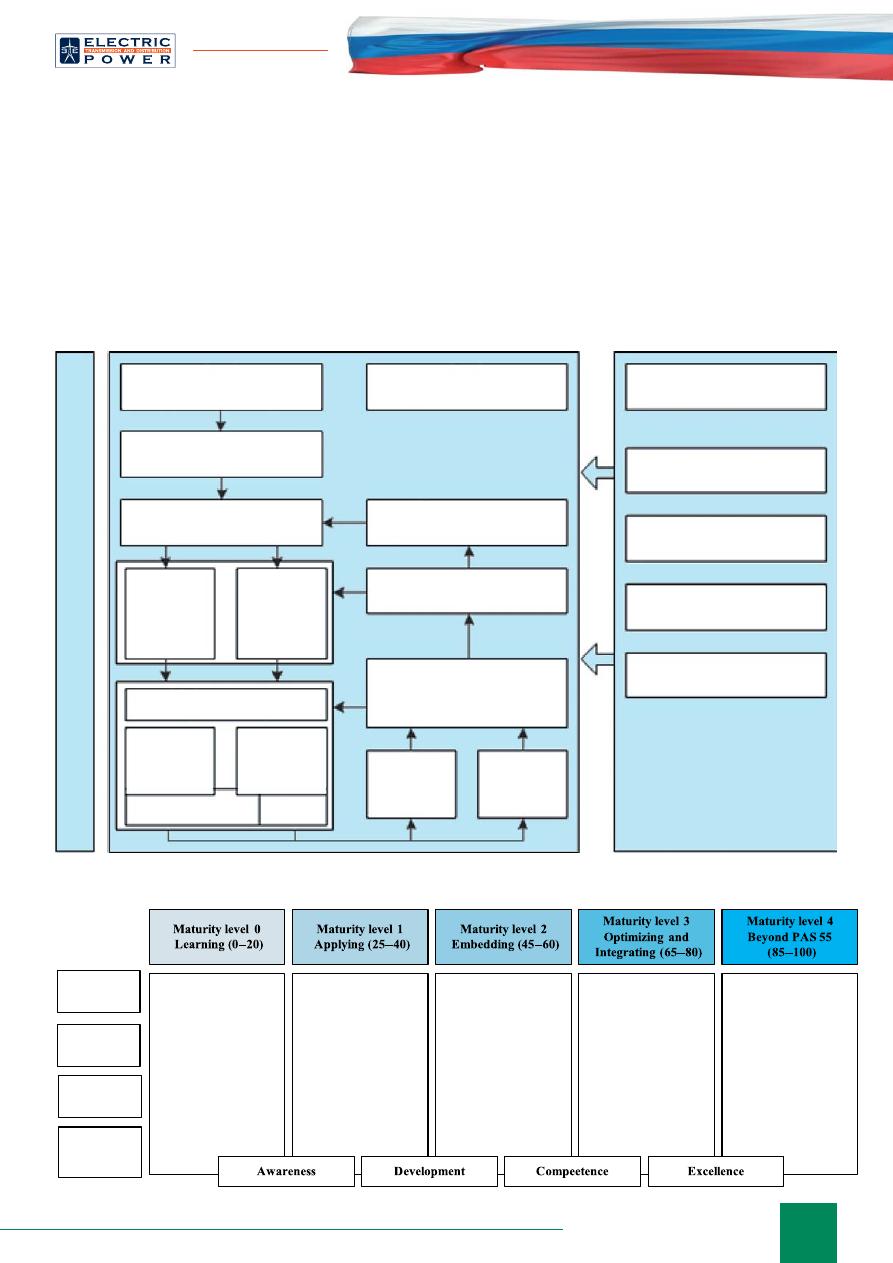
9
info@eepr.ru, www.eepr.ru
Position 3.3 re
fl
ects technical condition assessment
methods, asset performance, power supply reliability and
the costs.
Position 3.4 explains how the company assesses the
effectiveness of asset management, whether effectiveness
of subsidiaries and af
fi
liates are compared to identify best
practices in implementation?
Position 3.5 shows whether the results of planning
and execution of production programs in prior periods
are taken into account to justify the cost in the formation
of tariffs in accordance with the opportunities that the
company is developing at a certain level of PAM maturity
risk assessment and prediction of reliability and cost?
Section 4 de
fi
nes the requirements for resource
management (PAM enablers). The section contains 4
questions.
Position 4.1 generates for each PAM maturity level
characteristic properties of databases on equipment,
consumers, and
fi
nancial and economic activities of
Subsidiaries and “Russian Grids”?
Fig. 3. –— Physical asset management maturity model for JSC “Russian Grids” [11]
The elements required
by PAS 55 are not in
place. The organiza-
tion is in the process
of developing an un-
derstanding of PAS
55 and an upper-level
PAM model.
The organization has a
basis understanding of
the PAS 55 requirements
and develops an upper-
level PAM model.
It is in the process
of deciding how the
elements higher-level
PAM model will be
applied and starmed to
apply them
The organization has
a good understanding
of the upper-level
PAM model elements
arrangement. It has
decided how to apply
them and how they will
work in progression of
implementation.
All elements of the
upper-level PAM
model are in place
are being applied
and are integrated.
Using processes and
approaches that go be-
yond PAS 55. Pushing
the boundaries of PAM
development. The or-
ganization needs to
create new concepts
and ideas related with
the Smart Grid concept
implementation.
Fig. 2. Asset management upper-level model at JSC “Russian Grids”
Section 2
PAM Policy and Strategy
Section 1 – General Requirements
2.1. PAM Policy
2.2. PAM Strategy
2.3. Electric
grid
development
plan
2.4. PAM
development
plan
Operational –
maintenance
and repair
plan
Investment
plan
2.5. Operational and investment plan
Existing assets
New assets
3.1.
Maintenance
and repair
process
3.2. Renovation
and new
building process
3.3. Estimation of the assets’
conditions, performance,
reliability, risks and lifecycle costs
3.4. Audit process, Ef
fi
ciency
estimation process, Benchmarking
3.5. Tariff explanation process,
Finance strategy planning
Section 3 – PAM Processes
and Methodology
4.2. IT infrastructure and
technological solutions management
4.3. Organizational support and
human resource management
4.4. Management of changes and
continuous improvement
4.1. Data base management
Section 4 – Supplementary
PAM tools – PAM Enablers
Section 1
General
Requirements
Section 3
PAM Processes
and Methodology
Section 4
Supplementary
PAM tools –
PAM Enablers
Section 2
PAM Policy and
Strategy

10
August 25–29, France, Paris
Asset Management
Position 4.2 re
fl
ects characteristic properties of the IT
infrastructure of Subsidiaries and “Russian Grids”?
Position 4.3 describes the process of organizational
support and personnel management within the Asset
Management.
Position 4.4 provides a de
fi
nition of the change
management process and continuous improvement at
different levels of maturity of the PAM.
LEVEL 0 (Learning):
According to the PAM maturity model at the level
corresponding to the initial phase of learning:
- common PAM Policy as a high-level document is
missing while companies begin to realize the need
for the development and implementation of common
approaches;
• impacts on the assets are made at standard periodicity
and accidents, mainly considering periodicity.
Suf
fi
cient funds for maintenance and renovation
of the network determines the absence of the need
to introduce new approaches to asset management
regarding technical condition;
• grid development plans are formed without a long-
term asset management Strategy;
• asset management system development plan is missing;
• development of operational and investment plans
is taking into account the periodicity of the works;
consolidated feasibility planning operating and
costs investments (upgrade, new construction and
expansion of existing facilities) is not provided,
decision-making level at grid facilities (operational,
functional, short-term planning) is carried out at sites,
integrated plans are agreed in the branches and in
Subsidiaries;
• concepts of maintenance and repairs (overhaul, medium,
current) are
fi
xed in standard technical documents, but
the actual amount of work on each type of operational
and maintenance activities are not allocated, which
leads to dif
fi
culties in the implementation planning of
the facilities to the necessary extent;
• retro
fi
tting and upgrading, new construction and
expansion of existing facilities are not included in
uniform asset management package;
• structural assessment is carried out by experts, risk
assessment is not carried out or carried out by experts
at sites, there is no opportunity to forecast technical
condition, risk, reliability and cost;
• PAM effectiveness is performed in terms of plans
implementation — plan-to-fact analysis in physical
and
fi
nancial terms, there is disunity and heterogeneity
of the KPI: no PAM balanced scorecard , there are no
uniform methods for calculating “Russian Grids” and
Subsidiaries key performance indicators;
•
fi
nancial planning is based on extrapolation of data
from previous periods;
• branches and companies databases are scattered,
overlap, there are no common regulatory information
directories, information is incomplete and inadequate,
historical data at facilities is maintained in volumes
necessary only for the operation;
• data acquisition is on paper or in various IT systems
not integrated with each other, data processing is
automated partially, facilities are incompletely and
insuf
fi
ciently equipped with technical means for data
transmission;
• availability of methodologies and regulations for
individual processes, documentation independently
developed by companies, there are no uniform
methodology, the actual execution of regulations is not
complete;
• lack of staff with simultaneous head cutting and the
absence of training, the staff is not intended to change
the logic of PAM, comprehensive work on training
and staff development in asset management is not
conducted.
LEVEL 1 (Applying):
At this level of maturity — the phase of application
of international approaches to development and
implementation of the PAM target model:
• uniform asset management Policy is in the process of
development, it is assumed that corporate requirements
to asset management de
fi
ned by certain documents in
force at “Russian Grids” level are not worked enough,
companies and their branches could have possible
independent interpretations;
• companies are aware of the need to develop uniform
high-level documents, the impact on the equipment
is actually held by standard rate and frequency of
accidents, mostly - upon an accident;
• grid development plan is made excluding long-
term asset management Strategy but there is an
understanding of the need to consider when planning
the cost of risks and assets lifecycle;
• asset management development plan is in the initial
stage of development or is only valid at subsidiary level,
but is not consistent with “Russian Grids” plan, does
not cover all required PAM directions, responsibility,
authority are not clearly assigned, evaluation of results
is carried out at the level of company and “Russian
Grids” formally and irregularly because the need in
systematic understanding to work in this direction is
still emerging;
• plan for development and investment activity is
conducted taking into account the periodicity of the
works; asset management package includes MRO
process, Upgrade and new construction are not
included; consolidated technical and economic MR
and investment planning is not available; planning is
conducted at sites, the branches have the possibility to
monitor plan implementation, the asset management
balanced scorecard is in its initial stage of development
it does not embrace all the required asset management
directions in a common package, companies have their
own methods for calculation of individual indicators;
• concepts of MR are
fi
xed in standard technical
documents, but the actual amount of work on each
type of operational activities are not allocated, which
leads to dif
fi
culties in the implementation planning
of the facilities to the necessary extent; companies

11
info@eepr.ru, www.eepr.ru
independently form their own master-production
scheduling;
• structural assessment is carried out by experts, risk
assessment is not carried out or carried out by experts
at sites, possibility to forecast technical condition, risk,
reliability and cost are at initial stage of elaboration is
not available;
• PAM effectiveness estimation is based on plan-to-
fact analysis of operational and investment volumes
and cost, performance evaluation is carried out by
individual processes not organized in a common
asset management package, there are dif
fi
culties in
establishing a system of benchmarking for PAM in
branches due to the fact that building a balanced
scorecard of asset management is absent or is in the
stage of development;
•
fi
nancial planning is based on extrapolation of data
from previous periods;
• databases of Subsidiaries are not structured properly;
they are formed locally for individual projects and
overlap; handbooks of the common reference data are
composed by physical characteristics of the equipment,
fi
nancial and economical activities and budgeting
of grid companies, customer data; the data integrity
level is low, data management processes are under
formation, contents of data
fl
ows is being précised;
• data acquisition is carried out in different non-integrated
IT-systems, many processes are not automated (middle
automation level), no target model of Subsidiary IT-
infrastructure development is available or it is under
elaboration, de
fi
nition of access rights and formation
of data
fl
ow maps are being worked out;
•
Subsidiaries develop individually elaborated
documents, there is no common methodology for
different work
fl
ows is available in JSC “Russian Grids”
for its Subsidiaries, partial — in a Subsidiary for its
branches; regulatory document statements are executed
partially; the organizational structure of the company
and the personnel involved into the asset management
process — special asset management departments
monitor implementation of asset management
components; the personnel training and competence —
irregular; the personnel understands the need to change
existing work
fl
ows, targets and objectives of PAM are
explained to the whole personnel;
• targets of continuous improvement and changes are
de
fi
ned; however, correlation between the overall
corporative Strategy and the PAM strategy is not
properly de
fi
ned.
LEVEL 2 (Embedding):
At the maturity level “Embedding” of the target
PAM model:
• JSC “Russian Grids” has to elaborate and to approve the
common PAM Policy; basic correlations between the
strategy, the strategic targets of JSC “Russian Grids”
and Subsidiaries with regard to PAM are documented;
PAM objectives and development plans may correlate
with other policies of the company;
• the Strategy contains correlations of PAM short-
term and long-term targets and objectives with assets
lifecycle components; asset management is based
on time and risks (with consideration of the assets
condition and performance);
• they elaborate approaches to planning of grid
development with consideration of
fi
nancing resources
and risks;
• PAM development plans in Subsidiaries are elaborated
and approved in terms of uni
fi
rm PAM approach, the
people responsible for plan execution on Subsidiaries
and branches are assigned; however, responsibilities
and authorities for individual works are not properly
de
fi
ned; assessment of plan execution is performed
regularly in Subsidiaries and “Russian Grids”;
• PAM includes MR, retro
fi
tting and upgrading; there is
a possibility of long-term planning of total operational
and investment costs; new construction and existing
capacity enhancement work
fl
ows are now being
worked out;
• PAM is treated as a tool of long-term and short-term
planning, production program planning is carried out in
branches; Subsidiaries and “Russian Grids” supervise
this process. The key performance indication system
is properly de
fi
ned at all management levels;
• PAM methodologies and principles enable to estimate
the scope and the cost of work execution for individual
equipment, complex sites, grid sections within the
controlled object, transfer to calendar-scope planning
based on common principles;
• company use expert-analytical procedures for the
technical condition estimation; such procedures with
regard to risks, consequences and critical failures are
being elaborated and tested; no forecasting procedures
for technical condition, risks, reliability and costs are
available or they are being worked out;
• common reference data system is being established
that includes data on the equipment, customers,
fi
nancial and economic activities; data integrity level
is middle; though the databases are suf
fi
cient for
required analytical calculations, they are continuously
reviewed, information management processes are
re
fi
ned, archive data required for forecast purposes are
maintained;
• data acquisition and processing are carried out in
different IT-systems, the target IT-infrastructure
model is being reviewed and implemented; it enables
integration (automation level — suf
fi
ciently high),
de
fi
nition of data access rights and data
fl
ow map
formation at the initial stage of elaboration;
• common PAM principles, methodology and
procedures are approved for all companies (except for
low level processes); actual execution of regulatory
document statements — partial; characteristics
of the organizational structure and the personnel
involved into asset management processes —
special asset management departments that do not
combine production program execution and planning/
monitoring functions are available; regular training
of the personnel; PAM change logics is accepted;

12
August 25–29, France, Paris
Asset Management
suf
fi
ciently high level of understanding PAM targets,
objectives and methods;
• targets of continuous improvement and changing are
correlated with Subsidiary’ strategy and PAM targets at
all management levels; based on such correlation they
carry out a detailed review of requirements to PAM.
LEVEL 3 (Optimizing and Integrating):
At the third maturity level:
• PAM requirements are speci
fi
ed in detail in the
Common Policy and applicable documents related
to activities of JSC “Russian Grids” branches and
Subsidiaries; qualitative and quantitative correlations
between low level and higher level documents are
de
fi
ned properly; PAM Policy along with other policies
are updated and reviewed regularly;
• documents that de
fi
ne short-term and long-term PAM
targets and objectives are applicable; asset management
is carried out with consideration of the risks during the
whole asset life cycle;
• principles of the grid development process and the
grid accessibility are documented and applicable with
consideration of the asset life cycle cost;
• PAM development plans are elaborated, approved
and executed within the scope of a complex
approach to PAM; they are continuously updated
with consideration of the results obtained at
previous maturity levels and correlated with key
parallel activities (development of situational and
operational control processes, grid accessibility and
connection process, etc retro
fi
tting and upgrading,
new construction and existing capacity enhancement
work
fl
ows are included into the complex asset
management; procedures of investment project
portfolio formation are approved and applicable);
• planning of operational and investment costs is
provided with consideration of risks during the
whole life cycle of the equipment; PAM is treated as
a tool of long-term and short-term planning as well
as quick decision-making; planning is carried out in
Subsidiaries; estimation of the scope and the cost of
work execution is carried out for individual equipment,
complex sites, grid sections within the controlled
object with consideration of the technical conditions,
risks and the costs of asset life cycle;
• expert-analytical procedures and diagnosis are used to
estimate the technical condition and risks; forecasting
procedures for technical condition, risks, reliability
and costs are available;
• PAM balanced scorecard that correlates basic
production and
fi
nancial work
fl
ows is elaborated
and implemented; benchmarking system that enables
comparison of Subsidiaries and its branches by PAM
ef
fi
ciency is implemented;
• long-term (5—10 years)
fi
nancial planning is carried
out with consideration of data on grid development,
risks and the cost of grid site life cycles; plans are
précised annually;
• common reference data system is applicable in JSC
“Russian Grids” and Subsidiaries that includes data
on the equipment, customers,
fi
nancial and economic
activities; data integrity level is high; the reference
data is continuously updated, information management
work
fl
ow is properly de
fi
ned at all management levels,
archive data required for forecast purposes are acquired
and available;
• target IT-infrastructure model is being implemented;
it de
fi
nes the position of PAM systems, enables
integration of IT-systems and platforms, de
fi
nes data
access rights and data
fl
ow map formation; automation
level - high, level of equipment provision — suf
fi
cient
but not excessive;
• uniform PAM principles are applicable in all companies
of “Russian Grids”, common methodological and
regulatory documents cover key processes (except
the low level); actual execution of regulatory
document statements — suf
fi
ciently full; There
are special asset management departments that do
not combine production program execution and
planning/monitoring functions are available; regular
improvement of quali
fi
cation, consultations and
technical support are available; specialists have both
technical and economical skills, understand well PAM
targets and objectives;
• targets of continuous improvement are de
fi
ned and
correlated with PAM targets, continuous change and
supplement of PAM requirements at all management
levels is being carried out.
LEVEL 4 (Beyond PAS 55):
At the development level not covered by PAS 55
PAM system changes are provided by Smart Grid
concept:
• PAM Strategy is based on life cycle management
and combination of new approaches (including
consideration of Smart Grid technologies, active
consumer behavior, market price signals, etc.);
• grid development plan and grid connection processes
principles are documented and applicable with
consideration of the asset life cycle cost, integration
of the distributed generation into the network, demand
response, active consumer behavior, etc.;
• PAM development plans are regularly reviewed
with consideration of the results obtained, future-
proof trends of grid infrastructure development are
considered and correlated with parallel key processes,
online monitoring and estimation of results are
supported;
• overall technical and economical planning of
operational costs and investments into the
fi
xed capital
is provided with consideration of risks during the
whole life cycle of the equipment, change of consumer
behavior and forecasts of power transmission costs;
a well-balanced key performance indication system
enables proper distribution of responsibilities at all
management levels;
• component-wise scope and MR cost planning is
possible for the whole life cycle;
• retro
fi
tting and upgrading, new construction and
existing capacity enhancement, operational and

13
info@eepr.ru, www.eepr.ru
situational control processes are included into the
uniform PAM;
• technical condition and risk estimation can be
carried out in real time by using analytical methods,
possible forecasting of risks, reliability and costs with
consideration of active consumer behavior, grid self-
healing and self-supervision capabilities, market
signals, etc.; asset management balanced scorecards
and benchmarking are implemented; PAM ef
fi
ciency
assessment model helps the company to respond to
changes of the environmental conditions to improve
the decision-making ef
fi
ciency;
• long-term
fi
nancial planning with consideration of grid
development and correction of plans with consideration
of Smatr Grid technologies;
• common reference data system is established
and applicable, it is subject to regular update and
supplement, no data redundancy, the data scope is
suf
fi
cient, data management process is reviewed
following the requirements of data display in real time
systems;
• high level of IT-system integration, suf
fi
cient amount
of equipment for data exchange and processing,
possible online data receipt;
• monitoring/planning of productivity/reliability and
work execution are different activities;
• specialists have both technical and economical
skills, understand transformation of PAM targets and
objectives according to smart energy technologies;
• PAM is treated as a key tool of ef
fi
ciency improvement.
CONCLUSION
To evaluate the organizational level of company’s
maturity we performed the study of qualitative
characteristics of higher-level PAM model components
based on expert conclusions. The results show that today
the majority of companies have the level of maturity
“Application”, and some companies are transferring from
the
fi
rst to the second level “Embedding”.
JSC “Russian Grids” Subsidiaries understand PAM
properly, they work on developing different PAM model
components under the common concept, the established
methodological, organizational and informational base
is available for elaboration of complex solutions and
formation of the common asset management system
intended for short-term and long-term reliability and cost
management in operational and investment activities
during the whole life cycle of the assets.
To achieve permanent ef
fi
ciency of its activities and
to provide successful transition to a higher level, JSC
“Russian Grids” has to consider the most critical issues:
• elaboration of the Common PAM Policy;
• detailed elaboration of the higher-level PAM model;
• formation of PAM target-setting model and the PAM
ef
fi
ciency monitoring and balanced scorecard system;
• elimination of difference in PAM approaches of
distribution companies with regard to common
methodology and Standard documents, uni
fi
cation
of PAM approaches in JSC “Russian Grids”
Subsidiaries related to non-documented processes with
consideration of peculiar features of distribution and
transmission grids;
• elimination of automation imbalance in individual
Subsidiaries, improvement of the data exchange model
and the target architecture of the information systems
that enables actual and future PAM development.
The main aim of creation and implementation of a
complex PAM system is to change existing processes and
provision of successive transition from conventional cost
planning by the rate of maintenance to asset life cycle cost
management beginning from design till de-commissioning
and utilization as well as to risk management,
fi
nancial
and production ef
fi
ciency management of JSC “Russian
Grids” and Subsidiaries.
REFERENCE LIST
1. http://www.rosseti.ru/ — the of
fi
cial site of JSC
“Russian Grids”.
2. Executive Order of the Russian Federation Government
dated 03.04.2013
№
511
−р
“Strategy of Grids
Development in Russia”.
3. I.
О
. Volkova (2008). Ef
fi
cient PAM in Grid Companies:
Theory and Methodology. Edition of Polytechnic
University, Saint-Petersburg, 255.
4. Typical Standard of PAM in Distribution Grid
Companies of JSC “Russian Grids”, Order dated
11.05.2012
№
204.
5. Asset Management — an anatomy, The Institute of Asset
Management, Issue 1.1, 2012, http://theiam.org/what-
is-asset-management/anatomy-asset-management.
6. Volker, L., Van der Lei, T. E., & Ligtvoet, A.
(2011, October). Developing a maturity model
for infrastructural asset management systems.
In Proceedings of 10th Conference on Applied
Infrastructure Research—Infraday 2011, 7—8 October,
TU Berlin, Berlin. Carnegie Mellon University.
7. Swinarski, M., Jackson, E., & Kishore, R. (2008).
Conceptualization and Measurement of the Capability
Maturity Model (CMM): An Examination of Past
Practices and Suggestions for Future Applications.
AMCIS 2008 Proceedings, 106.
8. Kwak, Y. H., & Ibbs, C. W. (2000). Assessing project
management maturity. Project Management Journal,
31(1), 32—43.
9. De Bruin, T., & Rosemann, M. (2005). Towards a
business process management maturity model.
10. Chemweno, P. K., Pintelon, L., & Van Horenbeek, A.
(2013, September). Asset maintenance maturity model
as a structured guide to maintenance process maturity.
In 3rd MPMM (Maintenance Performance Measurement
and Management) conference (pp. 58—70).
11. BSI PAS 55 Assessment Methodology (PAM), The
Institute of Asset Management.
12. Asset Management Maturity Methodology, National
Infrastructure Unit, New Zealand, http://www.
infrastructure.govt.nz/.
13.
UMS Group PAS 55 Self-assessment, http://
umsgroupeurope.com/pas55/.
Оригинал статьи: Approach to Developing the Asset Management Maturity Model for JSC “Russian Grids”
At present, development and integration of uniform principles and mechanisms of physical asset management (PAM) in all subsidiaries of JSC “Russian Grids” is one of priority directions of the company’s activities. Assessment of PAM organizational maturity level is a tool which enables estimating the maturity degree of PAM components in Subsidiaries. At JSC “Russian Grids” the given tool was suggested as an auxiliary method of shaping PAM development plans of subsidiaries based on common logic. The approach for developing the asset management maturity model is based on quality analysis of conformance of Subsidiaries’ PAM to the upper-level PAM model of JSC “Russian Grids”. PAM maturity organizational level assessment model was developed with reference to the international standard PAS 55 and materials of international companies accredited for PAS 55-based qualifi cation, with account for the nature of currently implemented projects in transmission and distribution companies. The results of the conducted work were used for choosing main directions of PAM development at JSC “Russian Grids” and its subsidiaries.




